by Tom Gaylord
Writing as B.B. Pelletier
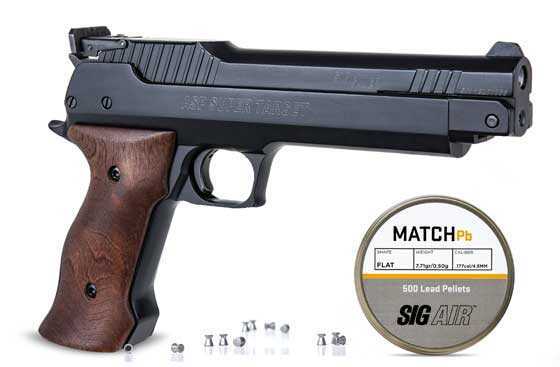
SigAir Super Target (photo provided courtesy Sig Sauer).
This report covers:
- Adjusting the trigger — first
- Adjusting the trigger — second
- Accuracy
- The test
- RWS Hobby
- Let’s examine that group
- Hobbys again
- Sig Match Pb
- RWS R10 Match Pistol
- H&N Finale Match Light
- Discussion
- R10 second try
- Summary
Here we go, guys. Today we look at the accuracy of the new Sig Super Target single stroke pneumatic (SSP) target pistol. I’ll tell you right now that it’s accurate. But there is a lot more to cover today, so let’s begin.
Adjusting the trigger — first
Two words of advice. First — don’t adjust the trigger — at least not until you shoot the pistol a little. Second — if you do try to adjust it — GO SLOW! I know that most adjustable airgun triggers require a lot of adjustment before anything can be felt. This one is different. Please listen to BB.
I tried each of the adjustments for you and wound up removing the pull weight adjustment screw from the pistol. It wasn’t easy to put it back in again — it took many tries over several days to get it back. It passes through the trigger return spring that puts tension on the screw as you are trying to start the threads.
I thought I would be the only one to do that until a reader contacted me and said he had done the same thing with his Super Target. When he contacted me I had already replaced the screw, so let me show both you and him what it looks like when it’s in the gun correctly.
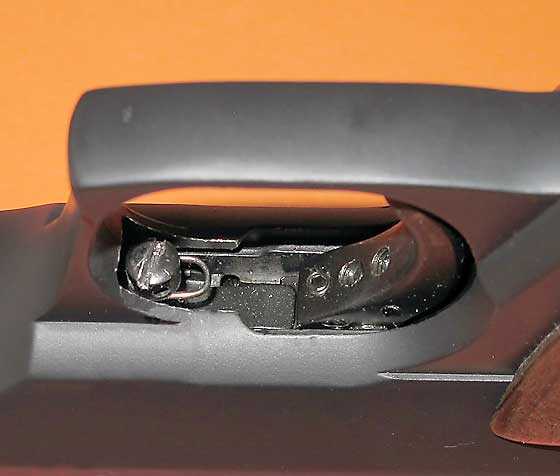
The big slotted screw on the left is the one that adjusts the pull weight. I turned it out too far and it popped out of the trigger. I then spent a lot of time trying to get it back. See the U-shaped wire spring that it passes through? That’s where the difficulty lies.
There is no hole through the triggerguard for a screwdriver to get on that screw, so the screwdriver has to come in from the side, yet still turn the screw straight into its hole. I even have short screwdriver bits and a sideways ratchet mechanism, but there isn’t enough room in the triggerguard for them.
Adjusting the trigger — second
Once the pull weight screw was back in place I found that all my “adjustments” were so far out of whack (my fault) that the trigger would not engage. So I cried, “Help!” to Sig and Ed Schultz sent me the following graphic.
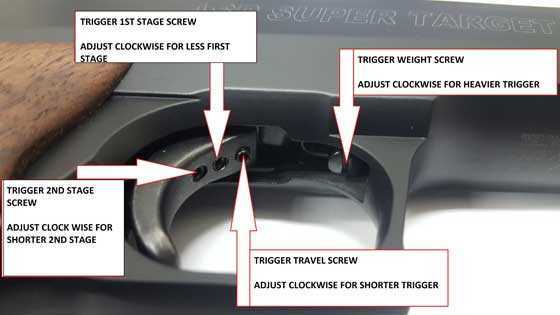
This graphic is very helpful getting the trigger back into adjustment. The manual has a drawing that is clearer, but I like this one better.
The manual says to adjust each screw slowly (in small increments, like a quarter turn) and they mean it! I started out adjusting like an airgunner, which is to say more is better, but this trigger is very sensitive and needs those small movements of each screw. Also, adjusting one screw affects all the others, so check after each small adjustment. I went from a 15-pound pull (estimated) to a 2-pound pull in just five or six quarter-turn increments!
There! I have told you what to do and how slow to do it. If you get in trouble now, it’s your fault. I learned the hard way, as did one of our readers. Pay attention and you don’t have to.
Accuracy
Today is accuracy day and we are all curious how the Super target shoots. This will tell you whether this is the air pistol for you.
The test
This is a 10-meter target pistol so I shot from 10 meters. I shot off a bench with two different holds that I’ll describe as we go. I shot 5-shot groups so I could shoot more targets. And, since an optical sight cannot be mounted on the Super Target, I shot with the adjustable sights that comes on the pistol.
RWS Hobby
First to be tested was the RWS Hobby pellet. I shot this group with the bottom of the pistol grip rested directly on the sandbag. Because the Super Target has open sights I started right at at 10 meters and the first shot landed in the black of the bull. Four shots later and I had a 0.89-inch five-shot group at 10 meters.
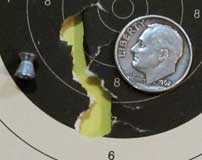
From 10 meters the Sig Super Target pistol put five RWS Hobby pellets into 0.89-inches between centers.
Let’s examine that group
That group tells me two things. First — why do pellets string vertically like that? That’s right — because the velocity varies from shot to shot.
Next — why do wadcutter pellets tear target paper? Right, again. Because they are traveling slowly. Target paper is designed not to tear.
Now for the important question. The Super Target is an SSP. How do we speed up the pellets from an SSP and also make the velocity more consistent, shot-to-shot? We do it by pumping partially before pumping the gun completely — to flex and warm up the pump cup or other piston seals. I really want to know how this Super target performs so I shot a second string of Hobbys while warming the pump cup this way. I’m still resting the bottom of the pistol grip directly against the sandbag.
Hobbys again
This time I partially pumped the pistol five times. Then I loaded a pellet and gave it another partial pump that was quickly followed by a complete pump. I could hear that the pellet flew faster this time. After five shots I had a 0.57-inch five-shot group that exhibited zero tendency to string vertically. That’s a group size shrinkage of more than three-tenths of an inch by just changing how the pistol is pumped.
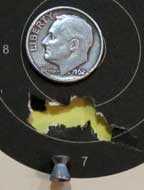
A second group of RWS Hobbys proved everything I said about velocity and consistency. Five shots are in 0.59-inches between centers at 10 meters.
Sig Match Pb
Next I tried 5 Sig Match Pb (lead) pellets. I was still pumping a partial pump before each complete pump, and the pistol grip is still resting on the sandbag. These five pellets strung out horizontally in a group that measures 1.435-inches between centers. I think this is not the pellet for this pistol.
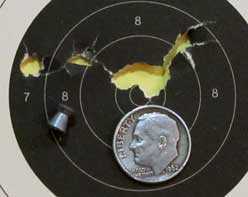
Five Sig Match PB pellets went into 1.435-inches at 10 meters.
I did try a second group with this pellet, using a different hold, but it was larger and more open than this one. This just isn’t the right pellet for this Super Target.
Okay, it was time to break out the big guns — premium pellets I know to be accurate in lots of different target guns. And perhaps I would also play with the hold. I adjusted the sights five clicks up at this time. I can’t hear the clicks and I think nobody can, but they are large and distinct.
RWS R10 Match Pistol
Next to be tried were five RWS R10 Match Pistol pellets. I was still holding the pistol with the bottom of the pistol grip resting on the sandbag.
The Super Target put five R10s into 0.543-inches at 10 meters. Now, we are talking! And look — my sight adjustment was almost perfect for this pellet!
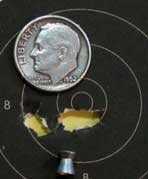
That is a group! Five RWS R10 Match Pistol pellets are in 0.543-inches at 10 meters.
H&N Finale Match Light
Since the R10 did so well I thought the next pellet — an H&N Finale Match Light — might do as well. So I changed the way I held the pistol. This time I held it off the bag with a two-hand hold and my hands were resting on the bag. Five pellets went into 0.432-inches at 10 meters. This is the group that convinced me that the Super Target can hold its own with any target SSP in its category!
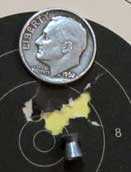
The Super Target put five H&N Finale Match Light pellets in 0.432-inches at 10 meters. This gun can shoot!
That group was so impressive that I decided to give the R10s a second try with the new hold. I was getting tired from all the concentration, but I knew I could hold it together for five more shots.
R10 second try
This time, with the pistol handheld, I put five R10 pellets in 0.682-inches at 10 meters. Four of the five are in 0.376-inches, so I think I’m getting past my expiration date on this day.
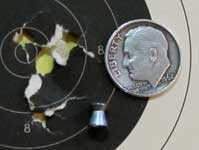
This second group of RWS R10 Match Pistol pellets was shot with the pistol handheld. It measures 0.682-inches between centers, with 4 or the 5 in 0.376-inches.
Discussion
It appears this Super Target pistol likes lighter target pellets over the heavier ones. But my test wasn’t very thorough, was it? Sig will just have to wait to get this pistol back, because I want to do more testing.
The trigger is an absolute delight to shoot. However, it is not a conventional target trigger. Stage two does not have a definite stop — at least not the way I have it adjusted. It’s a soft stop and stage two does have a very little movement. I can tell where it is at all times and it’s wonderful to work with. I know exactly when it gets ready to fire, and I can concentrate on the front sight for the release.
Pumping this pistol is so easy! It’s like eating peanuts — Hubs peanuts at that! I just can’t stop. It’s so much fun to shoot and I think most adults and older kids will be able to pump it.
The sights adjust exactly as they should. And they are crisp to see. I hope to zero them for the best pellet at some point in my testing, but that will be in the future — ha, ha!
Summary
The Super Target is an air pistol I have been waiting two years for. It’s everything I hoped it would be and even more. You Sig P210 firearm owners have got to add this to your collection. I am not done testing it yet. Stay tuned!

B.B.,
On your first close-up picture of the trigger to illustrate the screw which retains a U shaped spring there appears to be a hole on the side of the screw head. Is that for a set screw or it to allow the screw to be turned by a tool?
Siraniko
Siraniko,
Good eye! I did try using a paper clip to do just that, but the paper clip pushed the screw out of line with the hole.
A guy really needs one more hand for this one.
B.B.
Yes it does look like a capstan screw. The holes should let you turn it from the side. Maybe the short arm of an Allen key would work?
Timi,
Good thought but the hole is too small for anything larger than perhaps an 050 Allen wrench. See my answer to Siraniko above.
B.B.
BB,
If I didn’t have my Izzy, this would be on the short list.
Every airgunner should have at least one accurate air pistol in their collection. You can learn so much about shooting with something like this.
RR,
Yes. This is that accurate gun.
B.B.
Curse you sir!! Of course, I just had to google Hub’s Peanuts, and placed an order! 🙂
Kevin,
If you like peanuts you won’t be sorry! I was given a gift of Hubs peanuts 20 pounds ago. 😉
B.B.
Hi B.B.,
It was interesting to see what the Super Target is capable of with lead pellets. So far, I have only used alloy pellets, and have gotten good results. Because they are much lighter in weight, the velocity is higher, and I have not had any difficulties with my target paper tearing. The H&N Match Green pellets are all I happen to have on hand right now, but I know there might be other good options (maybe the Predator GTO wadcutters). If you have any other alloy pellets that you think might be a good match for this pistol, I would love to see them tested.
As an aside, I would like to clarify something that I saw in comments following your last post on this pistol (Part 3). Some seem to think that the Super Target is just a reskinned FAS 6004. There is some measure of truth to that, but it is not entirely accurate. SIG Sauer apparently required of Chiappa certain things that do set the Super Target apart from the FAS 6004, and there are some noteworthy positive improvements. For instance, the lock up between the frame and the overlever has been made more secure, using a more positive latch system (the FAS 6004 has only a small stamped metal tab holding the overlever in place, whereas this function on the Super Target is performed by the robust steel “hammer”). Also, the Super Target’s frame has been redesigned. Yes, this is mainly for aesthetic purposes in order to imitate the overall look of the P210 Target. However, the benefit is that the gun is stronger. The FAS 6004 has a one-piece wood ergonomic wood grip attached to the frame by a single (very large) bolt, similar to some shotgun stocks. With repeated pumping, this bolt can loosen. The larger contoured frame of the Super Target with its smaller grip panels eliminates this problem. Additionally, the rear sight has been redesigned. You have to be very careful in pumping an FAS 6004 not to let your hand drag over the rear sight, as it is thin piece of steel with very sharp corners (it will draw blood if you are not careful). The Super Target features a much thicker rear sight with rounded corners to guard against this problem.
As for the gun’s internals, I suspect that SIG Sauer has made contributions to quality control. My FAS 6004, though a good gun and quite accurate, does display considerable variance shot to shot. By contrast, alloy pellets shot from my Super Target varied by only 8fps fastest to slowest. That is much greater consistency. Overall, because of these refinements, I prefer the Super Target to the FAS 6004. SIG Sauer (and SIG AIR specifically) certainly seems to have gotten things right with their first attempt at designing a single stroke pneumatic!
The Super Target has quickly become my favorite SSP. I realize that there are other SSPs out there that are arguably better in terms of overall performance and suitability for 10-meter competition (I will make no claims that my Super Target can outshoot an FWB 103). However, as a trainer for my P210 Target, the Super Target is the best airgun I could ask for. The grip angle and ergonomics are almost perfectly equivalent. The trigger is, like that of the P210, highly refined, and can be adjusted to mimic the feel of the firearm’s trigger. The sights are (minus the fiber optic front) closely analogous as well. In short, the Super Target is a great stand-in for the P210.
Some may wonder if a P210-replica CO2 action pistol might be a better trainer. I don’t think so. While action pistols (like the new Springfield XDM BB guns) are great trainers for a lot of duty weapons since they disassemble just like their firearm counterparts, most of them are smoothbores that just can’t achieve the kind of accuracy needed to train for using a target pistol. Likewise, it is hard to make them with triggers as refined as that found on the P210, which makes an SSP like the Super Target a much better match.
Duke,
Wow, a second blog!
Thank you for your comments and I will try lead-free pellets for you next time. After the IZH 46M and Gene Salvino’s warning not to use them in SSPs I was being cautious.
B.B.
B.B.,
So she’s not just good looking, this gal is a shooter…nice!
Thanks for another great report, and for all you have done for us throughout the year. =>
Wishing a happy, safe, and blessed Thanksgiving to all,
dave
B.B.,
I have had good luck in reducing the velocity variance in some single stroke pneumatic pistols by seating the pellets. Especially the lower velocity ones. Based on your description of the breech chamfer in Part 2 it may not help in this pistol as much but may be worth a try. The low velocity guns can use up a lot of energy just getting the pellet skirt formed into the rifling. If the breech has any irregularities I think quite a bit of air can flow past the skirt before it conforms to the rifling.
Nice shooting, I have been following along a day or two late on the blogs, I have too many projects. I hope to get some spare time now that winter is setting in. It will be fun to get on the same page.
Don
I’m surprised and disappointed this isn’t available on the P.A. site yet, especially when one of the name competitors is selling it already.
Jim M.
A couple of points regarding the mechanism in comparison to the FAS 6004.
In general, SSP overlevers tend to have an internal hammer to open the valve, which is cocked during the opening/closing of the gun, making use of the compression cylinder rocking up and down. The HW40 /P3 and its clones, discussed in some detail recently, have the three arms in the valve housing that extend downwards and re-cock the hammer; Gamo use a [ shaped rod with the top end in the valve housing and the lower sitting in a curved slot in the hammer.
The FAS however is different, for those who’ve never seen one. The entire trigger and hammer mechanism is attached to the cylinder and moves with it as the gun is cocked – that’s why the trigger starts to disappear up into the frame while doing so. The hammer is driven by a coil spring on a strut that passes through a seating in the frame (to give the spring something to compress against) but then has a nut on the far end of it. On opening the gun, the hammer is held back while the trigger and sear move past it until the sear catches; closing the gun the hammer is pushed back and its spring compressed.
In order to accommodate this system in the Sig’s frame, a couple of slight changes have been required. The grip shape means the spring is angled downwards much more, but still passes through the same sort of seating – a separate steel pin with a hole across it. The hammer on the FAS is made up of 4 plates riveted together (the two outer plates are larger and extend either side of the valve stem) and it appears the hammer spring strut has had to be moved on the SIG, which has been done by using a new one-piece hammer.
For whatever reason, my gun also had a damaged breech seal out of the box as well, together with a large blob of grease in the breech and on the valve housing face. The top front edge of the valve housing does feel a little sharper on the SIG which might be related to the top surface looking like it has been machined flat, in comparison to the FAS which looks cast and then unfinished. This might just be for cosmetic reasons on the SIG, or to get a specific size that accommodates the interior surface of the overlever.
iain
This shows the difference between the angles of the hammer springs.
Credit to Muzzle.de for the cross section diagram, bear in mind it is the original FAS 604 with a trigger stop in the rear of the guard. (The position of the sear and hammer in the FAS, and mainspring strut in the SIG, show that both of these guns are cocked.)
http://www.muzzle.de/N3/Druckluft/FAS_AP_604/fas_ap_604.html
iain
Resting one gun on top of the other – triggers and muzzle lined up – gives an indication of the difference in grip position and angle between the two guns.
iain
Iain – UK,
Not only does resting one gun on top of the other show the grip position and angle difference but also the 6004 FAS’s substantially longer sight radius. It also shows the use of the undercut to the rear of the trigger guard as well as the absence of the Beaver Tail! The SIG needed to give up a number of key target/modern pistol features to be able to look more like the SIG P210 which after all started life as a Service/Duty Pistol! I will be interested in how much you feel these items contribute or detract from the Super Targets performance. I will say I have started shooting it (rested) and it is (my barrel) a very precise shooter out of the box. I find the ergonomics while doing dry fire drills to be very pleasant but be warned I have extra, extra large hands and long fingers. I think the provided grip size is probably best suited to medium to large handed shooters. With more shooting cycles my desire for larger (thicker) or perhaps a custom one piece right hand grip that lengthens my trigger finger reach (SIG AIR are you listening…$$, ££, €€, & ¥¥) may be finalized. I need to consiously keep from touching/pressing with my off trigger finger tips. I do not like strangling any pistol grip! Smaller grips tend to make that all too easily done.
shootski
From a brief session with it this morning (cold hands meant I wasn’t getting the best from it) I found it pleasant enough to shoot, and was able to zero it at 10 metres with RWS 7.0 grain ‘pistol’ Meisterkugeln. I will have to do a bit more with the trigger adjustment though, finding my finger starting to touch the frame before the gun would fire (the manual, by the way, is wrong in how to adjust screw 2). To my eyes, the sight picture didn’t seem quite as good as the FAS – in particular, I wonder if the foresight will allow you to get the best from the gun?
My comparison of the grips really wasn’t meant as a criticism of the SIG – I can understand the look they are going for – but they are the ones pushing the “it’s a target pistol” line, on page three of the instruction manual for example.
I wonder, though, if we will start seeing custom aftermarket or DIY grips sooner rather than later – seeing they are just flat panels on the back with only the top edge a critical fit, might they be an easier proposition to make?
Iain
Iain,
I used some sight black on the rear of my front sight blade. In different light I may try some white or green.
Different grips would be very welcomed if just to try. Unless the sales of this SIG AIR pistol takes off the custom DIY route may be our only options!
I’m very close on not having enough rearward travel on the trigger to get Let-off but I’m happy with my trigger as set by the factory thus far.
shootski
Just to pull together in the Sig post a couple of points I’d made elsewhere on the blog …
The SIG manual doesn’t include any parts list or exploded diagram, but the Chiappa manual for the FAS 6004 has both, and is available on their website. This gives details that are bound to be relevant to the SIG as well such as o-ring sizes – breech seal is 1.78mm cross section x 6.75 – but another useful detail is the trigger weight adjustment screw, listed as an ‘M3 x 6 t.cyl head’ but the diameter of the screw head isn’t anything special: an off-the-shelf M3 socket head screws engage correctly with the relevant spring
Dismantling the gun follows the same basic lines as the FAS 604 or 6004 – removal of the rear pivot pin linking the valve housing to the frame, and of the nut on the end of the hammer spring strut – that is, the internal hammer that knocks the valve open – allow the valve housing and compression cylinder to be lifted up out of the frame. Do bear in mind that the nut on the end of the hammer spring strut does more than just keep it as a nice captive unit, when opening the gun it has to hold the hammer back to allow the trigger to move past it.
It is possible to access alot of the gun in this condition, the only thing to watch is that the frame, cylinder and overlever can flop around a bit and can knock into each other.
A comparison of the FAS and SIG actions, the different grip shape and angle on the SIG requires the hammer spring to sit more vertically down the grip, you can see that it attaches to the hammer where the FAS hammer, which is laminated, has one of its rivets holding it together. Hence the SIG has a new, one-piece hammer. And also, now, a new allen head trigger weight adjuster.
A closer look at the SIG’s action, note how the replacement trigger weight screw still holds the spring in place. The hammer here is in the cocked position, and on my FAS 6004 the laminated hammer looks to have been ground to a fine corner where it engages with the sear. The SIG doesn’t look like it has had anything done to it – I imagine the part doesn’t actually need tidying up. It’s possible, then, that the SIG might have a more consistent feel to the trigger.
Iain